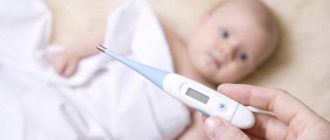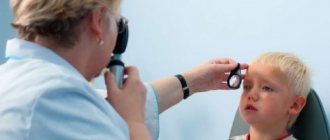Causes of inflammation
When a child has an inflamed lymph node behind the ear, it is better to make a timely diagnosis in the hospital than to guess on your own about the causes of this unpleasant phenomenon. Parents can only make an assumption about what became the provoking factor, and it can only be confirmed by a specialist. Usually in such cases the problem lies in the organs located nearby. It can be:
- ear problems: furunculosis in the ear canal, otitis media, sinusitis, nerve inflammation;
- weakening of the immune system due to any colds, acute respiratory viral infections, even a common runny nose;
- acute or chronic tonsillitis, pharyngitis;
- sinusitis;
- inflammatory and purulent processes, infected wounds in the oral cavity;
- dental caries: if a child has pain in the lymph node behind the ear, this may be inflammation of the dental nerve;
- syphilis and tuberculosis;
- HIV infection;
- all kinds of infectious diseases: scarlet fever, mononucleosis, measles, mumps, rubella, brucellosis, hysteriosis;
- fungal infection;
- lymphogranulomatosis, lymphosarcoma;
- allergic dermatitis;
- diphtheria of the tonsils;
- streptococcal sore throat;
- taking certain medications: allopurinol, atenolol, captopril, carbamazepine, cephalosporins, gold preparations, hydralazine, penicillin, phenytoin, pyrimethamine, quinidine, sulfonamides.
After identifying the real disease, due to which the inflammation of the lymph nodes behind the child’s ear began, it will be necessary to undergo a course of treatment, and their size will return to normal. In addition to enlarged lymph nodes, you can observe a number of other symptoms that will signal malfunctions in the small body.
Symptoms
Most often, enlarged lymph nodes behind the ears in children are accompanied by symptoms such as:
- increase in size, formation of soft swelling;
- temperature (from 37°C and above);
- malaise, lethargy, moodiness, insomnia, loss of appetite;
- if a hard lymph node behind a child’s ear resembles a lump, this may not be the first stage, but an advanced form of a serious and dangerous infectious process occurring in a small body;
- if hair begins to fall out and the amount of dandruff increases, the main disease lies in a fungal infection;
- headache;
- sometimes a child may not feel any pain with an enlarged lymph node, and sometimes when palpated, he cries: the pain will radiate to his submandibular region and ear;
- Sometimes, in the area of the enlarged lymph node behind the ear, the child experiences pustular rashes.
All these signs will help parents realize it in time and consult a doctor for help. If a child has an enlarged lymph node behind the ear, only a qualified specialist can prescribe the correct treatment.
Causes and symptoms
The causes of the disease are determined by the structure of the lymph node itself , as part of the lymphatic system. It includes the lymphatic vessels and the thoracic lymphatic duct. It is closely related to the functioning of the circulatory system and promotes the outflow of fluid waste by cells into the veins.
It is the lymph node that prevents infections of any kind from entering the tissue. That is why any focus of inflammation, when it spreads beyond the borders, can cause inflammation of the lymph nodes.
Other reasons are often the entry of cancer cells into the lymph nodes from organs located nearby where the tumor appeared. Most often, it is this sign that is identified as the first symptom of cancer.
Other causes include autoimmune diseases, lymphogranulomatosis, etc.
In general, the causes of pathology are the penetration of the following types of infections:
- treponema pallidum;
- actinomycetes;
- Brucella;
- plague stick;
- tularemia bacteria.
The provoking factors of the disease are:
- reduced immunity;
- the presence of any source of infection;
- erysipelas;
- frequent respiratory diseases;
- diabetes;
- chronic infections.
To protect yourself from this disease, you should avoid errors in diet, failure to comply with personal hygiene rules, and hypothermia.
To avoid this unpleasant phenomenon, you should pay attention to the symptoms of the pathology:
- an increase in the size of the lymph nodes and pain around them;
- headaches against the background of already enlarged nodes;
- unexpected sharp rise in temperature;
- presence of rash and severe itching.
As the disease progresses, external changes become noticeable, including the appearance of:
- tachycardia;
- fever;
- intoxication;
- sleep disorders;
- loss of appetite.
Find out more about the causes of lymphadenitis from the video:
Drug treatment
After the examination, the doctor will explain in detail what to do if a child has an inflamed lymph node behind the ear: what caused it, what course of treatment he prescribes, and even how to properly care for the problem area. Diagnosis includes a blood test (required), computed tomography (rare), x-ray, biopsy (only in extreme cases). Therapy primarily depends on the underlying diagnosis.
- Broad-spectrum antibiotics (penicillins).
- For allergies - antihistamines.
- Sulfonamides.
- General strengthening agents.
- For diseases of the ear canal, anti-inflammatory drops are most often prescribed.
- For pain, analgesics and anesthetics are prescribed.
- To eliminate swelling, physiotherapy is most often prescribed.
- When diagnosed with acute purulent lymphadenitis, complicated by a necrotic or phlegmonous process, surgical opening of the abscesses can be performed with subsequent prescription of drug therapy for inflammation.
However, drug treatment in such cases is not enough. We also need quality care at home. The doctor will tell you not only how to treat an inflamed lymph node with medications, but also how to properly handle it so as not to aggravate or worsen its condition.
Treatment regimen
The main goal of therapy is to eliminate the infection that caused the enlarged lymph node. As soon as the child recovers, the lump behind the ear will disappear. For this purpose, targeted drug treatment is prescribed. Depending on the form of lymphadenitis, a course of physiotherapy or surgical intervention will be required. Home care for a child plays an important role in recovery.
Medications
Drug treatment is a key part of overall therapy. Medicines eliminate the source of the problem. The course of treatment depends entirely on the patient’s diagnosis and the type of infectious agent. These can be antibiotics, antifungals, bactericides, antimicrobials.
Broad-spectrum agents are used, including penicillins, macrolides, azalides, sulfonamides, fluoroquinolones, aminoglycosides, etc. For example, Azithromycin, Co-trimoxazole, Clarithromycin and their analogues.
For ear infections, local treatment in the form of drops is indicated. Allergic reactions are eliminated with age-appropriate antihistamines. For a speedy recovery, vitamin or immunomodulating complexes are used (for frequent ARVI and colds).
Folk remedies
Self-treatment must be approached very carefully. In the case of the lymphatic system, it can easily be damaged and only make the situation worse. It is important to follow all doctor's instructions and prescriptions. He will give recommendations on proper home care for a small patient.
It is strictly forbidden to warm up swollen areas on your own. When heated, the abscess may burst and the infection will spread throughout the body. At home, you can use Vishnevsky ointment in the form of applications to treat lymph nodes. Echinacea tincture has a pronounced anti-inflammatory effect. Dilute the tincture with water in a 1:2 ratio, soak a bandage or cotton pad in the solution, and apply to the bump.
Other methods
If the doctor is sure that there is no suppuration in the node and the infection will not spread further, he will prescribe a course of physiotherapeutic procedures aimed at relieving inflammation and swelling. Typically dry heat and UHF are used.
If there is no purulent content in the lymph node, the doctor prescribes anti-inflammatory physiotherapeutic procedures to the patient
The presence of an abscess requires minor surgical intervention. The pus must be removed and the tissue cleaned. If the exudate does not find an outflow path, the capsule will constantly increase and then simply burst. As a result, infected pus will affect healthy organs and enter the bloodstream. The procedure is not the most complicated; the child’s body quickly recovers after such interventions. To consolidate the result after surgery, drug therapy (antibiotics, antimicrobial, bactericidal and anti-inflammatory drugs) is prescribed.
Home care
If the lymph nodes behind the ears of a child are enlarged, the doctor will advise the parents to care for the patient as carefully as possible, since this symptom is very important for the entire small organism. A few useful recommendations will speed up your baby’s recovery and significantly alleviate his condition.
- Under no circumstances should you warm an inflamed lymph node with anything: this can provoke further spread of the infection, which will lead to a permanent deterioration in the baby’s condition.
- For the same purpose, avoid compresses.
- You need to take a course of multivitamins that will strengthen the immune system.
- In the off-season, in damp and cold weather, dress your child warmly, but not too hot, so that he does not sweat or get cold. Take special care of your head and ears: a hat made of natural material should be appropriate for the season.
If you find enlarged lymph nodes behind the ears in your child, you should not try to cure him with grandma’s remedies, as the cause may be too serious. The only right decision in such a situation is to contact a pediatrician who can make an accurate diagnosis and prescribe the right treatment. This will avoid complications and will contribute to the baby’s speedy recovery from any illness.
New articles
we are in social networks
up
source: www.vse-pro-detey.ru
Lymph nodes are an important part of a child's immune system. This is where the body confronts the antigens of microorganisms; this is a kind of center for fighting infections. The nodes are collections of lymphocytes that produce antibodies.
The lymph nodes, together with the spleen and tonsils, create immunity. They are located throughout the body, the largest clusters of them are in the neck, ears, armpits and groin. These nodes are a collection of different cells: T lymphocytes, B lymphocytes, macrophages and antigen presenting cells. Here, in the lymph nodes, lymphocytes multiply and immunoglobulins (that is, antibodies) are synthesized against antigens that enter the node along with the lymph.
A child’s lymph nodes have the ability to change their size. The size of the node depends on age, its location and the number of infections.
Prevention of inflammation of the lymph nodes
In order not to encounter such a serious disease as lymphadenitis, it is necessary to carry out preventive procedures:
- Try to avoid injuries near the nodes;
- Avoid infection of injured skin areas;
- Treat chronic diseases in a timely manner;
- Identify and treat colds in a timely manner;
- Visit the dentist regularly with your child;
- Observe the rules of child hygiene;
- Avoid purulent processes on the skin and treat any damage with antiseptic drugs;
- To maintain immunity, it is recommended that children under one year old include more foods enriched with vitamin C in their diet and harden them.
If you suspect lymphadenitis in your baby, you should consult a doctor who will make an accurate diagnosis and prescribe the correct treatment. Independent home treatment is unacceptable, since home-grown therapy can lead to the development of serious consequences: meningitis or sepsis.
Causes of enlarged lymph nodes behind the ear
Enlarged lymph nodes in a child (lymphadenopathy) are a manifestation of a pathological process occurring in the body, and lymphocytes or macrophages that multiply as a result of this enlargement contribute to the appearance of a pathogenic microbe antigen in the body.
In order to find the causes of enlarged lymph nodes in a child, it is necessary to identify a potential source of infection in their vicinity. Knowledge of which area a particular group of nodes flocks to is also valuable.
Injury
If the neck is injured, there is a chance that the lymph nodes behind the ear will become enlarged. This will be caused by the body trying to repair damaged tissue. In the case of a cut or bite, there is also a high chance of swollen lymph nodes behind the child's ear as the immune system begins to produce more antibodies to protect against infection through the wound.
Tooth abscess
This is the development of infection in the soft tissues of the jaw, which most often results from advanced caries. During this process, germs and pus accumulate in the gums. The affected tooth becomes very sensitive to heat. This infection is usually accompanied by a fever and often swollen lymph nodes behind the ear.
Infection
If there is a local or general infection, the body fights it, which is often accompanied by enlarged lymph nodes. This is due to increased antibody production. In case of infection of the upper respiratory tract, eyes, or scalp, there is a high probability of swelling of the lymph nodes behind the ears.
Rubella
This is a highly contagious disease caused by a virus. Children who are not vaccinated most often suffer. It is accompanied by a red or pink rash on the skin, hence the name. It first appears on the face and then spreads down to the rest of the body. In addition to the rash, swollen lymph nodes behind the ear, head, and neck may be observed.
Enlarged lymph nodes behind the ears in a child can be caused by:
- infection of the ear (otitis media, furunculosis in the ear canal), eyes, throat (pharyngitis, acute or chronic tonsillitis), or scalp;
- inflammation of the dental nerve, caries, gingivitis;
- mouth ulcers;
- fungal infection;
- autoimmune diseases;
- ARVI, colds;
- infectious diseases: mononucleosis, rubella, scarlet fever, brucellosis, measles;
- allergic reaction to food, household chemicals, taking certain medications, etc.
The child has swelling under the ear on his neck and it hurts
If the lymph node in a child’s neck on one side is enlarged, this may indicate not only some kind of inflammatory process in the body, but also the onset of more serious pathologies. As a rule, in a healthy state, the lymph nodes in the neck of children are slightly noticeable upon palpation or cannot be palpated at all.
In the chronic form, in children suffering from colds, constant enlargement of the lymph nodes may be the body’s natural fight against infection.
Performing the function of eliminating foreign microorganisms, unilateral enlargement of the lymph node is not a natural process for the body. That is why a careful consideration of the nature of lymphadenitis, identification of the causes, and their neutralization is required.
If a child has an enlarged lymph node on one side of the neck, it is necessary to identify and eliminate the cause as soon as possible in order to eliminate the likelihood of developing cancer. This article explains why lymph nodes can become enlarged in children, how to deal with it, and what symptoms accompany lymphadenitis.
More serious and rare causes
Autoimmune disease
Autoimmune diseases such as lupus and autoimmune thyroiditis can also cause such symptoms. Enlarged lymph nodes occur as a result of the destruction of the immune system. But the good news is that such serious health problems are rare in childhood.
Cancer
Some types of cancer are accompanied by lymphedema. It is the main symptom of blood cancer and lymphoma, which cause malignant cells to spread throughout the body. After these cells enter the lymph nodes behind the ear, an active fight begins there, which causes the enlargement of these organs.
Also, swollen lymph nodes behind the ear can be the result of HIV/AIDS or fungal and parasitic infections.
Symptoms
In most cases, an enlarged lymph node behind the ears in children is accompanied by accompanying symptoms, which depend on the cause of this enlargement. These symptoms may include:
- elevated temperature (37°C and above);
- headache;
- lack of appetite;
- drowsiness, lethargy;
- pustular rashes in the parotid area;
- pain when palpating an enlarged lymph node;
- With fungal infections, swollen lymph nodes may be accompanied by other symptoms (flaky scalp, itching, or hair loss).
Treatment
The treatment process for enlarged lymph nodes behind the ear depends on the cause that caused such a symptom. Bacterial infections are usually treated with antibiotics. Children who experience pain are prescribed painkillers. If swollen lymph nodes behind the ear are caused by allergies, treatment usually includes antihistamines and anti-inflammatory tablets. Children with autoimmune diseases may be prescribed immunosuppressive medications.
Mild swelling of the lymph nodes behind the ears or in any other area is usually not a serious cause for concern. However, if these areas are painful and increase in size, then it is important to consult a doctor to discover the cause. In some cases, this may be a symptom of a serious illness.
Additional research may be required:
- assessment of the prevalence of the inflammatory process in the body (for example, the concentration of the CRP protein);
- virological studies, in case of suspected viral infection;
- bacteriological studies if a bacterial infection is suspected;
- Ultrasound examination of suspicious lymph nodes.
However, most often, enlarged lymph nodes behind the ear in a child return to their original size after the infection disappears and do not require deeper diagnosis.
source: zdorovko.info
As a response to general or local pathological processes in the body, the child often becomes inflamed in the lymph node behind the ear, in the parotid region and on the neck. If the inflammatory reaction is confirmed, lymphadenitis is diagnosed, the treatment of which depends on the stage of the process, the type of primary disease, the degree of intoxication, etc. However, if the lymph nodes behind the ears of the child are enlarged due to lymphotropic viral infections, which include the herpes virus, infectious mononucleosis , adenovirus and cytomegalovirus, drug therapy is often not necessary.
Why does the child's lymph node behind the ear become inflamed?
If the lymph nodes behind the child’s ears become hard and convex, resembling a lump in appearance and to the touch, it means that the inflammatory process has been going on for a long time
Lymph nodes perform several functions in our body. The most important of them is filtration. In this way, the body is protected from the invasion of various pathogenic agents. Accordingly, any changes in the lymph nodes (their enlargement, thickening, redness) indicate the onset of pathological processes in the body. Let's consider what to do if a child has an inflamed lymph node behind the ear, how it manifests itself and why.
Symptoms of inflammation
An inflammatory process in the lymph nodes (lymphadenitis) or enlargement of the lymph nodes without inflammation (lymphadenopathy), which occurs against the background of a disease, is accompanied, first of all, by the symptoms of this disease. That is why the appearance of an enlarged node behind the ear in children can be difficult to notice immediately. But there are special signs of the inflammatory process, and they are represented by the following deviations from the norm:
- the lymph node is enlarged so much that it is visually noticeable;
- palpation can either cause pain or not be felt at all;
- the child complains of headache, chills or fever, the temperature rises;
- Children’s mood may deteriorate, they become capricious, sleep poorly, lethargic and refuse to eat;
- in some cases, the skin over the tubercle turns red;
- the condition of the hair deteriorates (it becomes brittle, dandruff appears).
In rare cases, lymphadenitis and lymphadenopathy may be asymptomatic. This is a very bad sign! A complete examination of the child’s body is required immediately.
If the lump behind the ear is hard to the touch and hurts even without palpation, this is a symptom that the infection has been developing for a long time, and the inflammatory process is at an advanced stage. If your child complains of pain in the ear or under the jaw, he should be examined independently: in some cases, this may be a manifestation of pathology in the lymph node.
Possible reasons

Any type of sore throat and acute respiratory viral infection can cause inflammation of the lymph nodes behind the ear in a child
Lymph nodes are distributed throughout the body and appear depending on the organs or structures in which pathological processes occur. Behind the ears are the cervical and postauricular lymph nodes. They can respond to changes in the nasopharynx, ears and mouth, brain, skin, soft and hard tissues.
In a healthy state, the lymph node cannot be palpated, is invisible visually, is not fused to the skin and does not cause any discomfort.
If we talk about lymphadenitis (inflammation) and lymphadenopathy (increase in size), then these conditions can occur as a result of various factors. There are the following possible causes of enlarged lymph nodes behind the ear in a child:
- acute or chronic form of pharyngitis, tonsillitis or laryngitis;
- sinusitis, rhinitis, sinusitis;
- caries, stomatitis or periodontal disease at an advanced stage;
- inflammatory processes in the ears (otitis media, etc.);
- furunculosis;
- wounds or ulcers in the mouth that do not heal well and are a source of infection;
- damage to the oral mucosa by a fungal infection;
- any type of sore throat;
- meningitis;
- infectious viral diseases, for example, rubella, measles, chickenpox, influenza, etc.;
- some allergic reactions;
- cold;
- benign or malignant neoplasms.
Most often, the cause of an enlarged lymph node behind the ear in a child is a cold, flu, or one of the diseases of the ENT organs. If the lump becomes inflamed on only one side, this indicates the localization of the pathological process.
Dangerous complications
If there is no timely, and most importantly, correct treatment, then this condition can give rise to the development of one of the following complications:
- adenophlegmon, that is, a diffuse purulent process;
- brain abscess;
- various hearing disorders;
- facial paralysis;
- sepsis and meningitis.
If you do not want to allow the development of such complications, then you should not conduct experiments on your child and use methods from the chest of traditional medicine. It is necessary to consult a pediatrician for diagnosis and selection of the correct therapy.
Causes of enlargement and inflammation of the lymph nodes behind the ear
An increase in behind-the-ear “bumps” most often becomes a manifestation of a reaction to processes taking place in the nasopharynx and oral cavity. So, for example, if a general blood test does not show any deviations from the norm, the child’s condition is normal, the “bump” behind the ear does not hurt, and the remaining nodes of the lymph system are not enlarged, there is a high probability that teeth are being cut. In this case, no special treatment is required.
However, it is necessary to clearly distinguish between the concepts of “enlargement” and “inflammation” of the lymph node (lymph nodes) behind the ear in a child.
In childhood, a painless increase in “bumps” is detected regularly (sometimes several times a year) and often does not require an immediate medical response. After various viral diseases of the nasopharynx, the lymphatic system will necessarily respond by increasing the size of nodal formations in nearby lymph groups (cervical, submandibular and sometimes parotid).
And although the increased size may persist for another month after the underlying disease has been cured, this in itself is not a sign of a dangerous inflammatory process.
If a child’s lymph node behind the ear is inflamed and painful, an urgent need to consult a doctor who will both treat the primary diseases and prevent the possible spread of the inflammatory process. Not every increase in the filtering nodal “station” leads to its inflammation. However, only a doctor can diagnose the condition of the peripheral lymphatic network based on a general blood test.
Inflammation differs from simple enlargement of the node:
- soreness (both constant and when touched),
- redness (blue discoloration) of the skin over the “bump”,
- an increase in temperature in the affected area,
- rapid swelling of the node during the day.
The change in skin temperature over the “bump” changes with bacterial infections and, as a rule, does not change with viral ones.
Soreness behind the ears “bumps” may indicate a reaction to otitis media, sore throat, colds, flu, chronic tonsillitis, childhood infections (scarlet fever, diphtheria), skin diseases. At the same time, the very fact of a painful reaction of the lymphatic system is not enough for diagnosis. In order to accurately determine the causes of inflammation of the lymph nodes behind the ear(s) in a child, the entire range of symptoms is taken into account.
Adenoviral infection is manifested by nasal congestion, conjunctivitis, and sore throat. Rubella and measles are accompanied by a characteristic skin rash. With infectious mononucleosis, the spleen and liver become enlarged, and all lymph groups swell. In case of careless contact with pets (especially cats), cat scratch disease can develop, in which the group of lymph nodes serving the scratched area becomes inflamed due to infection with bacteria. In this case, patients take a course of antibiotics for 10-14 days. With viral diseases in the neck and head, a multiple increase in small subcutaneous “buckshot” nodes can be observed.
Diseases related to potential causes of changes in the condition of the lymph node can be divided into:
- immune (rheumatism, lupus erythematosus, etc.),
- infectious (for example, mononucleosis),
- tumor.
Specific lymphadenitis, according to the nature of the clinical picture, are of the following types:
- Tuberculous. It is characterized by the involvement of several nodes on both sides, which are soldered into lumpy dense formations. The process may be accompanied by the release of pus or a curdled mass if the integrity of the capsule is violated.
- Actinomycotic. It is characterized by a sluggish inflammatory process that spreads from nodular formations to surrounding tissues. Accompanied by thinning and discoloration of the skin over the “bumps”. One of the probable signs is the formation of a fistula with an outlet.
- Bubonic. Occurs with tularemia and is characterized by an increase in the size of the nodular formation to 3-5 cm, adhesion to the underlying tissues, suppuration of the bubo and the formation of a fistula with purulent discharge.
Diagnostics
Typically, diagnosis begins on the basis of pronounced external symptoms of the disease . At the same time, a specialist can diagnose acute nonspecific lymphadenitis quite quickly.
It is somewhat more difficult to diagnose complicated forms of pathology, especially if it occurs against the background of severe symptoms of another infectious disease.
To diagnose lymphadenitis, the following examinations are prescribed:
- general blood analysis;
- ultrasound examination;
- X-ray methods;
- lymph node biopsy.
The development of specific lymphadenitis can be confirmed by data obtained from studies such as:
- tuberculin tests Pirquet and Mantoux;
- microscopic examination of punctate;
- X-ray of the chest and neck, armpits, under the jaw or in the groin area;
- Doppler ultrasound of lymph vessels;
- CT scan;
- lymphoscintigraphy;
- magnetic resonance imaging;
- X-ray contrast lymphography.
At the appointment, the doctor examines the patient as follows:
- First, a visual examination to identify noticeable enlargements of the lymph nodes, their mobility, adhesion to each other or to surrounding tissues. Palpation of the nodes is carried out from top to bottom from the area located under the jaw, behind the ears, on the back of the head.
- Next, located on the neck, above and below the collarbone are examined When diagnosing the lymph nodes of the armpits, you need to spread your arms slightly. Then the nodes in the groin area and on the back of the knee are examined.
- Changes in lymph nodes located deep in the chest or in the abdominal cavity can be examined exclusively using ultrasound, X-ray, MRI or CT .
Lymphadenitis can also appear in young children. It often occurs when teeth erupt in the area behind the ears. It rarely causes pain and sometimes goes away on its own after a few months.
It does not require special attention and serves as a sign of insufficient functioning of the baby’s immune system, the formation of which is not completed during this period.
Generalized lymphadenitis that appears unexpectedly requires concern, because may be a sign of HIV infections, tuberculosis or even blood cancer.
Long-term enlargement of lymph nodes in children sometimes occurs due to their chronic enlargement, infectious mononucleosis, located in the neck, under the jaw, behind the ear due to chronic forms of tonsillitis, sinusitis, and otitis media.
Monitoring the state of the lymphatic system and treatment
The process of immunity formation in adults and children differs in the degree of activity, therefore, the reaction of the children's lymph system to the infectious process is a common and expected phenomenon, which most often does not require separate therapeutic intervention.
However, in the case of inflammation of the lymph node behind the child’s ear, treatment is prescribed; a general blood test performed immediately before the appointment can help the doctor determine what to do if the lymph node is inflamed. In the absence of pathology, to monitor the state of the lymphatic system, such a blood test (with the leukocyte formula present in it) is sufficient to carry out twice a year.
In general, the treatment of all secondary lymphadenitis is associated with the relief of infectious and inflammatory processes and with getting rid of the disease that led to the spread of viral, bacterial, fungal or tumor pathology.
If a viral disease is successfully cured, even if the increased size of the painless node remains (and in the absence of other signs of suppuration), treatment for lymph formation is most often not prescribed. Within two weeks to a month, the behind-the-ear node usually returns to normal on its own. In this case, the behind-the-ear “bump” may not have time to go away completely if the underlying viral disease recurs or if a new one arises in the service area of this lymph group. A situation is possible when an enlarged node first becomes a consequence of a viral infection, and then a reaction to an erupting tooth. That is, two different causes alternately lead to the same effect, but in both of these cases, treatment of the lymphatic “bump” directly (for example, by applying ointment) is not carried out.
For chronic and acute serous nonspecific lymphadenitis, conservative therapy is used:
- antibiotics (semi-synthetic penicillins, cephalosporins, macrolides),
- desensitizing agents,
- dry heat,
- compresses with Vishnevsky ointment,
- UHF,
- immunostimulants and vitamins.
If there is no therapeutic effect with conservative treatment or if lymphadenitis develops into a purulent phase, the child is hospitalized for an emergency opening of the suppuration, drainage and sanitation of the lesion.
For necrotizing lymphadenitis, various methods are used to remove foci of inflammation. In the postoperative period, complex detoxification and anti-inflammatory treatment is performed.
source: lorcabinet.com Enlarged lymph nodes behind the ears of a child
Even the most minor external and behavioral changes will not escape the watchful eye of a caring mother. tubercles of unknown origin have formed behind his ear . You are overcome with anxiety. What could it be?
THE CONTENT OF THE ARTICLE:
► Lymph nodes, their function; ► The lymph nodes behind the child’s ears are enlarged. Causes and symptoms; ► Factors provoking enlargement and inflammation. Causes and symptoms; ► Treatment of lymph nodes.
There are lymph nodes on every person's body. They are found in the mouth, neck, shoulder, chest, abdomen, elbow, groin and knee areas. Lymph nodes are an important component of the immune system; they can rightfully be considered the center of the fight against various infections. Together with the spleen and tonsils, they provide the body with immunity. This is where the main resistance to foreign microorganisms occurs.
Enlarged lymph nodes behind the ears of a child
In the lymph nodes, immunoglobulins are synthesized and lymphocytes multiply . To make it easier to understand, imagine that the lymph nodes are a kind of border guards who guard the safety of the body. When an infection enters it, an inflammatory reaction occurs. Swelling of the lymph nodes is a signal that disturbances have occurred in the system and health problems have arisen.
A feature of the lymph nodes is that they can increase in size if they are located near the source of infection.
Diagnosis and treatment according to Komarovsky
To determine the cause of inflammation of the lymph nodes in a child’s neck, the doctor first of all conducts a detailed examination of the affected area and palpation. Additional instrumental and laboratory tests are also prescribed.
A lymph node biopsy is necessary, which is prescribed if anti-inflammatory drugs are ineffective. Also, a diagnostic measure is carried out if there is a significant increase in the node, when its diameter exceeds 3 centimeters and if the development of a malignant neoplasm is suspected.
If a biopsy is necessary for a child under 1 year of age, general or local anesthesia is used, depending on the complexity of the diagnosis. If there is a need for surgery, the specialist takes a sample of biological material from the lymph node and sends it for laboratory testing. In this case, you can determine the type of tumor present and the most effective treatment.
According to Dr. Komarovsky, diagnosis of enlarged lymph nodes in the neck in children should be carried out only in a good virology laboratory. It is thanks to modern equipment and highly qualified specialists that the most accurate diagnostic results can be achieved.
If the viral etiology of the inflammatory process in the lymph nodes is confirmed, the doctor advises not to carry out any specific treatment. Their size will return to normal as soon as the body's defenses cope with the pathogenic microorganism. If the inflammation of the nodes is associated with a staphylococcal or streptococcal infection, antibacterial therapy is carried out.
The lymph nodes behind the child's ears are enlarged. Causes and symptoms
One of the largest lymph nodes is the parotid. In their normal state, they have a soft consistency and are usually not palpable. If for some reason you have now noticed them (the size has increased, the color of the skin has changed, a painful reaction has appeared), then study the following information and pay a visit to the doctor. Maybe your concern is completely unfounded, nothing bad happened, and there is no reason to worry. But it's better to play it safe and find out for sure.
What you need to pay attention to right away: - determine the size of the lymph node (it can increase to the size of a walnut); - check whether there is pain when pressing; — assess the condition of the skin (red with elevated temperature or natural); — can the node move freely under the skin; — check the integrity of the oral mucosa; — find out if there are any injuries or abrasions on the head.
Along with enlarged lymph nodes, the child may experience the following reactions: - increased body temperature above 37°C; - fatigue, lethargy and drowsiness; - itching and flaking of the skin on the head (with a fungal infection). -weak appetite or lack thereof; - pustular rashes around the ear; - headache; - pain on palpation.
How should you proceed?
If you notice that the lymph nodes behind the ears of a child are enlarged, then until you contact a specialist, try not to touch them again, and make sure that the baby does not do this.
Observe their size, make sure that this place does not press or irritate anything. And most importantly, don’t overheat!
Factors that provoke enlargement and inflammation of lymph nodes
As mentioned above, such a reaction of the body is a response to disturbances in the functioning of internal organs. If an enlarged lymph node appears behind a child’s ear, it may be the result of the fact that the baby has:
a) infection of the ear, throat or eyes;
b) caries or inflammation of the dental nerve; c) sores or wounds in the mouth; d) viral infection or cold; e) infectious disease (rubella, measles, scarlet fever); f) allergies to dust, animal hair, household chemicals, food, etc.
Provoking factors can also be long-term foci of infection, diseases of internal organs and pets. Why is this happening?
With any injury, the body attempts to repair damaged skin and muscle tissue. During a bite or cut, the immune system also increases the production of antibodies to prevent infection from entering through the resulting wound. If you and your baby do not pay attention to oral hygiene, the fact that the lymph nodes behind your child’s ears are enlarged may be a reward for this. That is, inflammation can be caused by a problem with the teeth.
Neglected caries very often leads to an abscess. Around the source of infection, microorganisms accumulate and soft tissues are destroyed. The body begins to fight. Body temperature rises, lymphocytes are produced and the nodes behind the ear enlarge. An identical process occurs if the infection enters through another route, for example through injury, through the eyes, upper respiratory tract or skin.
Another common and noteworthy cause is a viral disease such as rubella. Children who do not receive vaccinations in a timely manner are at risk. Red or pink spots appear on the body , hence the name of the disease. In addition to skin manifestations, the troubles we are considering may be added. More serious and fortunately rare factors include autoimmune diseases and cancer.
Enlarged lymph nodes behind the ears in a child - treatment
The first are autoimmune thyroiditis and lupus . They can cause similar symptoms. The immune system is completely destroyed, which entails an increase in lymph nodes. The only consolation in this case is that such a problem is very rare in children.
As for a disease such as cancer, it should be noted that some types of it are accompanied by lymphaderma. Malignant cells spread throughout the human body. Some of them enter the lymph nodes, and an intensified fight against foreign bodies begins, which explains the enlargement of the lymph nodes behind the child’s ears.
For all suspicious mothers, I would like to say that slight swelling in this area is not yet a cause for premature concern. But you shouldn’t treat such manifestations of the body negligently, especially if these places cause pain and gradually increase in size. Contact your doctor for clarification.
An experienced specialist will examine the child’s ears, oral cavity and pharyngeal mucosa and assess the level of the inflammatory process. If no visible causes are identified, and the lymph nodes exceed the permissible parameters, then you will have to undergo a number of additional examinations:
- when diagnosing a viral infection - virological studies; — assessment of the level of prevalence of the inflammatory process (detection of protein concentration); - for suspicious lymph nodes - ultrasound examination; - bacteriological examination for bacterial infection.
The specialist will prescribe treatment depending on the identified causes.
If it is a bacterial infection, then you will eliminate it with the help of antibiotics. If, due to enlargement of the lymph nodes behind the ears of a child, he experiences pain, he will be prescribed pain-relieving medications. If an allergic reaction causes the nodes to increase in size, then anti-inflammatory and antihistamine tablets will come to the rescue. Immunosuppressive drugs are prescribed to patients with autoimmune diseases.
But drug support alone in such cases is not enough. A sick child needs home care. To prevent an exacerbation and for the baby to recover as quickly as possible, parents must adhere to certain rules:
It is forbidden to apply heat to the lymph nodes and make compresses! Such actions will provoke an expansion of the source of infection and worsen the patient’s condition.
To strengthen the immune system, you need to take a full course of multivitamins.
For preventative purposes, dress your child according to the weather. The child should not be sweaty while walking, otherwise he can easily get blown away. Take care of your head and ears.
Attention! Any treatment and manipulation is carried out exclusively under the supervision of the attending physician. Do not try grandmother’s recipes on your child, and do not attempt to cure yourself. An incompetent approach to eliminating symptoms can only lead to aggravation of this problem and serious consequences.
In conclusion, I will add that most often the enlargement of the lymph nodes behind the ears in a child returns to its normal state after some time without outside intervention. I wish you health and good health.
Find out right now about the most useful drug Plantex for newborns (instructions for use). For colic, constipation, bloating, regurgitation and to normalize digestion.
source: ideales.ru








